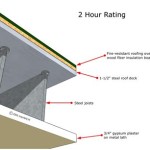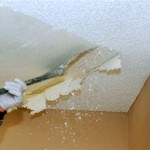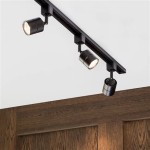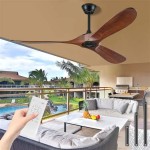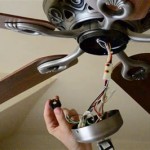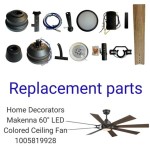Ceiling Fans for 8' Ceilings
Choosing the right ceiling fan for an 8-foot ceiling requires careful consideration of various factors to ensure both optimal performance and aesthetic appeal. This involves understanding the relationship between ceiling height, fan blade size, downrod length, and overall room size.
Standard 8-foot ceilings are common in many homes. While they offer a cozy atmosphere, they present a challenge when selecting a ceiling fan. The goal is to maximize airflow without compromising headroom and safety. A minimum clearance of 7 feet between the floor and the fan blades is recommended to prevent accidents. This leaves a relatively small margin for error in rooms with 8-foot ceilings.
The primary factor influencing a ceiling fan's suitability for an 8-foot ceiling is the fan's hanging height. This refers to the distance from the ceiling to the bottom of the fan blades. Flush-mount ceiling fans are designed to hug the ceiling closely and are the ideal choice for low ceilings. These fans often feature integrated light kits and come in various styles to complement different interior designs.
For ceilings slightly higher than 8 feet, or where a greater degree of airflow is desired, a ceiling fan with a downrod may be suitable. A downrod is a metal pipe that extends the fan from the mounting bracket, lowering the fan blades further from the ceiling. Selecting the correct downrod length is crucial for achieving the proper clearance. Downrods are available in various lengths, typically ranging from 2 inches to 72 inches. For 8-foot ceilings, a short downrod, usually between 2 and 6 inches, is generally appropriate. Longer downrods may be necessary for sloped ceilings or higher mounting points, but are generally not recommended for standard 8-foot ceilings.
Blade span, also known as sweep size, is another important consideration. Blade span refers to the diameter of the circle created by the rotating fan blades. Larger blade spans move more air but require greater clearance. For 8-foot ceilings, smaller blade spans, typically ranging from 36 to 48 inches, are generally recommended. Larger fans, while capable of moving more air, may feel overwhelming in a smaller room with a low ceiling.
Room size is a key determinant of the necessary airflow. A larger room will require a fan with a greater blade span and potentially a higher motor speed to effectively circulate air. Conversely, a smaller room will benefit from a smaller fan to avoid excessive airflow and potential drafts. For smaller rooms with 8-foot ceilings, a fan with a 36 to 42-inch blade span is often sufficient. Larger rooms with 8-foot ceilings may benefit from a 44 to 48-inch blade span, provided there is adequate clearance.
Beyond these practical considerations, aesthetics also play a role in choosing a ceiling fan. Ceiling fans are available in a wide array of styles, from traditional to modern, to complement various interior design schemes. Finishes include brushed nickel, bronze, and matte black, among others. Light kits can be integrated into the fan design or added separately depending on individual lighting needs.
Installation should always be performed according to the manufacturer's instructions. Ensuring proper wiring and secure mounting is essential for safety and performance. If uncertain about any aspect of installation, consulting a qualified electrician is recommended. Proper installation also ensures the fan operates quietly and efficiently.
Maintenance is crucial for prolonging the lifespan of a ceiling fan. Regular dusting of the blades prevents dust buildup, which can impede airflow and create imbalance. Periodically checking the screws and connections ensures the fan remains securely mounted. Lubricating the motor according to the manufacturer's recommendations can help prevent wear and tear and maintain smooth operation.
Energy efficiency is an increasingly important factor for consumers. Ceiling fans can contribute to energy savings by reducing reliance on air conditioning. Look for fans with Energy Star certification, which indicates that the fan meets certain efficiency standards. Furthermore, utilizing the fan's reverse function during colder months can help redistribute warm air trapped near the ceiling, further reducing heating costs. This involves reversing the direction of the blades to push warm air down into the living space.
By carefully considering these factors - ceiling height, fan blade size, downrod length, room size, and aesthetic preferences - homeowners can select the perfect ceiling fan for their 8-foot ceilings, ensuring both comfort and style. A well-chosen ceiling fan enhances the ambiance of a room while providing efficient air circulation.

Wingbo 60 In 8 Blades Led Indoor Black And Grey Ceiling Fan With Remote Wbcf Bs101 Bw The Home

Commercial Electric High Velocity 8 Ft Indoor Outdoor Matte Black Ceiling Fan With Wall Control Included Ak366a Mbk The Home

Dinglilighting 60 Ceiling Fan With Light And Remote Control 8 Blade Indoor Outdoor For Livingroom Bedroom Covered Patios Porch Grey Walmart Com

Tribeca Large 8 Blade Black White Led Ceiling Fan

Panasonic Ceiling Fan Products Malaysia

Ohniyou 76 Large Indoor Outdoor Ceiling Fans With Light And Remote 8 Blades Downrod Modern Farmhouse Fan For Living Room Shop Patio Black

Fan Types For Every Room

Havells Octet 1320 Mm 8 Blade Ceiling Fan Asiaplusbd

8 Blades Designer Ceiling Fan Warranty 2 Year At 4900 Piece In Jodhpur Id 21131585930

Martec Albatross 8 Blade Ceiling Fan Temple Webster
See Also

